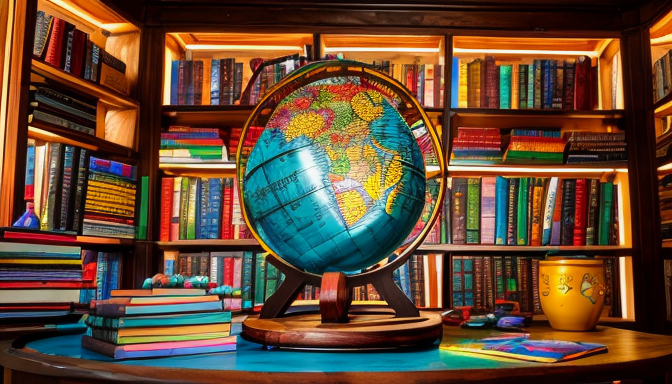Creating a fictional universe is like painting on a blank canvas, where every brushstroke adds depth and vibrancy. To truly bring your world to life, you need to delve into the intricate web of culture that binds its inhabitants. Think about it: culture is the heartbeat of your world, influencing everything from the way people interact to the stories they tell. So, where do you begin?
First, consider the geography of your world. Is it a sprawling desert, a lush forest, or perhaps a bustling metropolis? Each landscape shapes the way cultures develop. For instance, a society in a harsh desert might value resourcefulness and community, while one in a fertile valley may prioritize agriculture and trade. Next, think about the political structures that govern your cultures. Are they ruled by a monarchy, a democracy, or a council of elders? These systems will dictate how power is distributed and how conflicts arise.
Don’t forget about mythology! Every culture has its tales and legends that explain their origins and values. Crafting these stories not only enriches your world but also provides characters with a rich backdrop against which they can grow and evolve. When you weave together these elements—geography, politics, and mythology—you create a tapestry that is not just believable but also engaging for your readers.
In essence, worldbuilding is a dynamic process that requires careful thought and creativity. By understanding the nuances of culture, you’re not just creating a setting; you’re inviting your audience to step into a world that feels as real as their own.
Elements of Culture
When diving into the art of worldbuilding, understanding the fundamental components of culture is like laying the foundation for a magnificent castle. Without a solid base, your entire structure could crumble! Cultures are rich tapestries woven from various threads, including traditions, beliefs, and social structures. Each element plays a crucial role in creating immersive and believable societies that resonate with your audience.
Let’s break it down a bit. Think of traditions as the heartbeat of your culture. They encompass rituals, festivals, and daily practices that define a community’s identity. For instance, a harvest festival could symbolize gratitude for nature’s bounty, serving as a gathering point for families and friends. Meanwhile, beliefs—whether they stem from religion, philosophy, or folklore—shape how characters perceive their world and interact with it. They can be as simple as a superstition or as complex as a structured religion, influencing decisions and behaviors.
Social structures, on the other hand, dictate how individuals relate to one another. Are there hierarchies in place? Is there a communal approach to decision-making? Understanding these dynamics can create rich narratives filled with conflict and growth. Consider how different cultures might view leadership or family roles—these perspectives can lead to fascinating interactions and even conflicts between characters.
In summary, when crafting your fictional universe, remember to explore these elements deeply. They don’t just add flavor; they are essential ingredients that bring your world to life!

Cultural Interactions and Conflicts
When diving into the realm of worldbuilding, understanding is like unearthing hidden treasures. Just think about it—every time two cultures meet, it’s a potential explosion of ideas, customs, and sometimes, even tensions. This dynamic is crucial for creating a rich narrative. Imagine a bustling marketplace where traders from different lands exchange not just goods but also stories, beliefs, and even rivalries. The interplay between cultures can lead to fascinating alliances or dramatic confrontations, which can drive your plot forward.
To effectively portray these interactions, consider the following essential elements:
- Trade: The lifeblood of cultural exchange, trade opens doors to new ideas and innovations.
- Diplomacy: Negotiations and treaties can either mend or exacerbate tensions, showcasing the delicate balance of power.
- Conflict: Disagreements over resources, beliefs, or territory can lead to wars or peaceful resolutions, adding layers to your story.
Moreover, these cultural dynamics can serve as a backdrop for character development. For instance, a character torn between their heritage and the influence of another culture can create a compelling internal conflict. This struggle can resonate with readers, making your characters relatable. By weaving these interactions into your narrative, you not only enrich your world but also create a canvas where your characters can evolve and thrive amidst the chaos of cultural clashes.
Frequently Asked Questions
- What are the key elements to consider when creating a culture?
When crafting a culture, think about its traditions, beliefs, social structures, and values. These elements form the backbone of your society and help make it feel authentic and relatable.
- How do cultural interactions enhance storytelling?
Cultural interactions, such as trade, diplomacy, and conflict, add layers to your narrative. They create opportunities for character growth and plot twists, making your story more engaging and dynamic.
- Can cultures evolve over time in a story?
Absolutely! Just like in real life, cultures can change due to various factors like technological advancements, environmental shifts, or social movements. This evolution can add depth and realism to your world.
- How can I avoid stereotypes when building cultures?
To steer clear of stereotypes, do thorough research and draw inspiration from diverse sources. Create nuanced characters that reflect the complexity of real cultures rather than relying on clichés.
- What role does conflict play in cultural interactions?
Conflict can be a powerful catalyst for storytelling. It not only drives the plot forward but also reveals the values and motivations of different cultures, making the narrative richer and more compelling.

Recent Comments